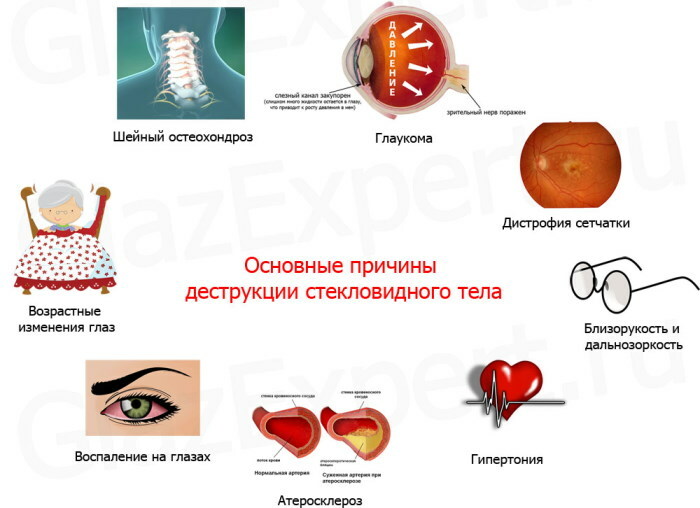Content
- What does EEG (electroencephalography) mean, the essence of the study
- In what cases are EEG prescribed for children
- Are there any contraindications?
- Does it hurt to do an EEG?
- Is it harmful to do EEG for children?
- Can an EEG be done at home?
- Preparing the child for the examination
- Choice between EEG with partial or total sleep deprivation (EEG with sleep deprivation)
- EEG algorithm
- Short EEG (15-20 min)
- EEG monitoring of daytime sleep (up to 5 hours)
- EEG monitoring of night sleep (up to 9 hours)
- Which method is preferable for children
- What factors can affect the results of electroencephalography
- Child mobility
- Breath
- Dream
- Photosensitivity
- Loud noise
- Video image
- Evaluation of results
- Indicator standards
- What do deviations from the norm say?
- What to do in case of violations
- Research cost
- Video about EEG for children
EEG (encephalography) in children is a kind of hardware diagnostic method that displays the functional activity of the cerebral cortex. With this method of examination, the doctor gets the opportunity
check the performance of the central nervous system child, timely detect pathological disorders, or make sure that the patient's neurons provide normal impulse transmission.What does EEG (electroencephalography) mean, the essence of the study
Electroencephalography is a special method of examining brain tissue. The use of this diagnostic procedure makes it possible to investigate the level of interaction of cells of the central nervous system of neurons in part of the conductivity and speed of transmission of electrical impulses from the center to the peripheral nerve endings.
The general indicator of the performance of brain cells reflects the bioelectric activity of its tissues, the speed of reactions to external and internal factors, irritants, the ability to perform complex operations associated with ensuring the full life of the body child.
The essence of the hardware study in the form of an EEG is to detect areas of the brain that have signs of pathological changes. During the diagnosis, the doctor examines all parts of the child's central nervous system, applies special tests to create a provocative load on neurons.
In children who do not have brain diseases, encephalography displays a stable neuronal activity of cells with a sharp increase in their performance during contact with factors irritants. For example, if at the time of the study the doctor shines a flashlight into the child's eyes, forcing the pupils to reflexively narrow and expand, asks to recite a poem, to collect small parts of the toy.
All changes in brain activity are recorded by a computer device, and then transferred to a blank sheet of paper. EEG results are a graph with a large number of dashed and curved lines. The deciphering of the encephalographic study is carried out by a psychiatrist, a neurophthisiatrist, or a neurologist.
It all depends on the signs of what disease the child is diagnosed with at the preliminary stage of the examination. After detecting areas of the brain with incorrect functioning of the central nervous system, an individual treatment regimen for the patient is created to prevent further progression of the disease.
In what cases are EEG prescribed for children
EEG is prescribed for children who have signs of disorders in the work of the brain. This diagnostic method is used in order to identify areas of the central nervous system with normal central nervous system function, and to highlight foci of pathologies.
Electroencephalography is prescribed for the following cases:
- epileptic seizures;
- sudden cramps of the lower extremities and muscle tissues of other parts of the body;
- suspicion of the presence of cancerous and benign brain tumors;
- dizziness;
- frequent loss of consciousness or light-headedness;
- circulatory disorders in the tissues of the brain;
- unstable psycho-emotional state of the child, accompanied by irascibility, constant crying;
- suspicion of encephalopathy;
- syndrome of acquired or congenital autonomic dystonia;
- cerebral palsy;
- fast fatiguability;
- impaired coordination of movements;
- autism;
- psychological disorders (especially if diseases of this category are present in blood relatives, and their origin has a hereditary etiology);
- brain concussion;
- unreasonable tantrums;
- drops in blood pressure;
- insomnia and sleep disturbances;
- previous trauma to the skull;
- sleepwalking;
- attacks of severe headache.
Electroencephalography can be assigned to a child during the first 12 months of his life to assess the physiological state of the cerebral cortex. For example, if, after a preliminary examination of the baby, the doctor has reasonable suspicions that the newborn is lagging behind in physical or psycho-emotional development. EEG is indicated for children over 1 year old who are hyperactive, have obvious speech defects, have learning difficulties, and have memory problems.
Are there any contraindications?
EEG in children (the norm and disturbances in the functioning of the neurons of the central nervous system are determined during one diagnostic procedure) has practically no contraindications. The examination is postponed to another time and date if the child has signs of a respiratory illness. For example, a runny nose or cough is present. Electroencephalography may be contraindicated in patients with infectious and inflammatory diseases of the scalp. You will need to be examined by a dermatologist, restore the integrity of epithelial tissues, and stop foci of acute or chronic inflammation.
Does it hurt to do an EEG?
The electroencephalography procedure does not cause any pain.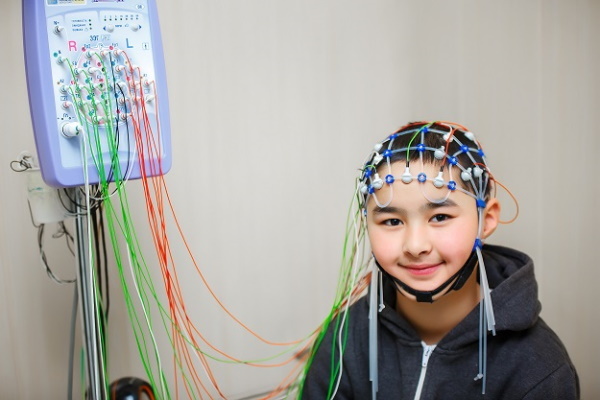 During the entire examination process, the child is in a sitting or lying position. At the same time, he does not experience discomfort or other symptoms of unsatisfactory health associated with the effect of the EEG apparatus.
During the entire examination process, the child is in a sitting or lying position. At the same time, he does not experience discomfort or other symptoms of unsatisfactory health associated with the effect of the EEG apparatus.
Is it harmful to do EEG for children?
Electroencephalography does not have a harmful effect on the cerebral cortex, internal organs or life support systems of the child. The only drawback of this procedure is that the patient must remain motionless during certain periods of the examination.
Can an EEG be done at home?
Electroencephalography is performed only in a specialized office of a private diagnostic center or a public hospital. This procedure requires a soundproof room with limited light access, a medical couch and appropriate equipment. EEG is not done at home.
Preparing the child for the examination
The advantage of electroencephalography in diagnosing the functional state of the central nervous system of a child is that this method has a high level of information content, but it does not require complex preparatory manipulations.
Before visiting the clinic, you will need to comply with the following rules:
- 2-3 days before the examination, play a game with the child, during which he needs to put on a special hat on his head, and then lie down in a calm state for 15 to 30 minutes. These actions will allow psychological preparation.
- On the evening before the day of diagnosis, the child's hair should be well washed.
- Upon arrival at the diagnostic institution, hairpins, elastic bands and other fixing devices, ornaments are removed from the surface of the child's hair.
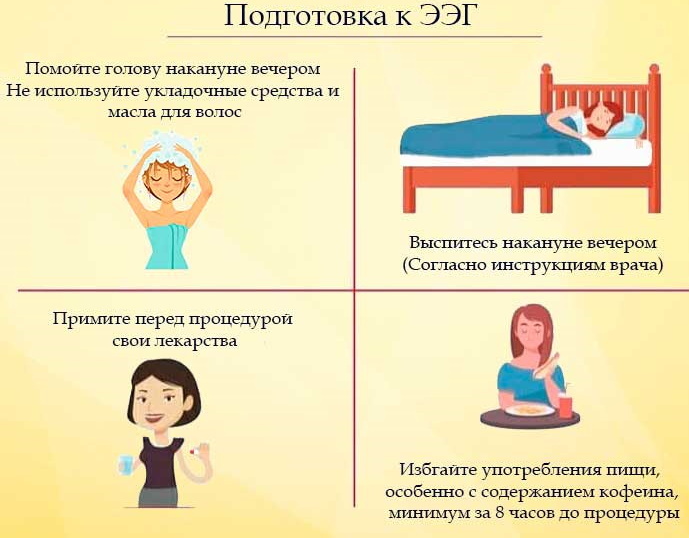
Before entering the office for the EEG, one of the parents explains to the child that he will now be examined by a doctor. It is important to emphasize that the procedure itself is completely painless, and also resembles a game that he played 2 days ago.
Choice between EEG with partial or total sleep deprivation (EEG with sleep deprivation)
EEG in children (the norm and disturbances of the neural activity of the brain are determined by a neurologist) is prescribed by the doctor after a preliminary examination of the child. The doctor may perform electroencephalography with complete or only partial sleep deprivation of the patient being examined. The duration of the absence of proper rest is determined individually by the doctor who performs the diagnosis.
For children, the EEG method with complete deprivation is practically not used, since it provides for the absence of sleep for 24 hours. After the expiration of the specified period of time, the doctor conducts an electroencephalography of the brain, the tissues of which were without rest during the day. A partial deprivation EEG is performed after a sudden interruption of the child's daytime sleep.
EEG algorithm
Standard electroencephalography with an examination duration of 15-20 minutes, as well as a longer study of the child's central nervous system, is carried out in compliance with the established norms of the diagnostic protocol.  At the same time, the age of the patient and his general state of health are taken into account without fail.
At the same time, the age of the patient and his general state of health are taken into account without fail.
Short EEG (15-20 min)
The usual study of brain tissue using EEG is performed according to the following algorithm of actions:
- Parents together with their child go to the office for electroencephalography.
- Newborn babies sit on the changing table, while older patients sit on the couch.
- A special helmet is put on the surface of the child's head, which outwardly resembles a rubberized and fabric cap with many electrodes. This procedure is carried out by a medical professional.
- Electronic sensors connected to the electroencephalograph with thin wires are connected to the electrodes of the EEG helmet.
- Medical equipment is grounded.
- The doctor turns on the electroencephalograph. From this moment, the recording of the neural activity of the brain tissues begins when the child is in a state of physical rest.
- At the command of the doctor, the patient opens and closes his eyes, takes deep breaths, sharp exhales of air, looks at a source of bright light.
- After recording the electroencephalographic data, the parents together with the child leave the premises of the diagnostic room, and then await the interpretation of the examination results.
Depending on the symptoms of a particular CNS disease that are present in a particular child, the doctor may use other test loads to identify areas with pathological damage to the tissues of the head brain. Infants undergo a standard EEG in the background without any specific exercises.
The younger child may be asked to play with toys. The average duration of this diagnosis does not exceed 30 minutes. According to the results of standard electroencephalography, the doctor determines the epileptic activity of the brain child, the level of development of its parts of the central nervous system responsible for speech, memory, coordination of movements, psychomotor functions.
EEG monitoring of daytime sleep (up to 5 hours)
EEG in children (the norm and disturbances in the functioning of the cells of the nervous system reflect the general state of the patient's cerebral cortex) with monitoring of daytime sleep is carried out for 5 hours. In this case, the medical personnel perform similar actions to connect electroencephalographic equipment to the surface of the child's cranium. During sleep, the patient is in a state of complete physical rest.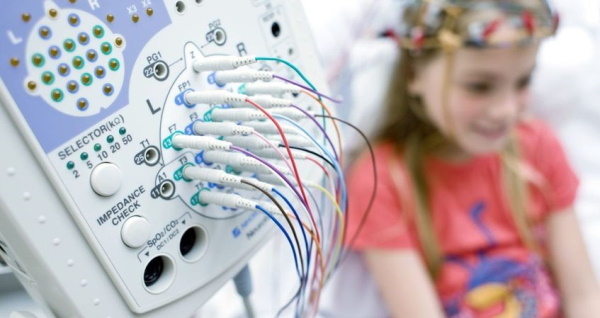
During this period, computer equipment records the background work of the child's cerebral cortex. The use of this EEG method is especially effective for examining children under the age of 2 years. During the daytime sleep, the child does not show physical activity, allowing the doctor to get the most objective diagnostic results. The electroencephalogram is transferred to a blank sheet of paper, and a copy of the medical data is stored on an electronic medium.
EEG monitoring of night sleep (up to 9 hours)
Electroencephalography during nocturnal sleep displays the bioelectrical activity of neurons in the brain, which are in a state of relative rest for a long time. The doctor conducting the diagnostics records the level of the central nervous system performance at different times.
In this case, before going to bed, a helmet with electrodes is put on the child's head, and then it is connected to sensors on a wired connection to the electroencephalograph. The volumetric diagnostic results, which were collected over 9 hours, are analyzed by a special computer program. The transcript of the study is transferred to a blank sheet of paper, and a backup copy of the EEG of the night's sleep is stored on an electronic medium.
Which method is preferable for children
For children of the younger age group under the age of 12 months, as well as up to 3 years, it is preferable to use the EEG monitoring method during daytime or nighttime sleep. At this time, the child's cerebral cortex will work as steadily as possible, which will allow a more detailed study of the functional state of all parts of the central nervous system. Children over 3 years old, who can already follow the doctor's commands, obey their parents, the use of standard electroencephalography is shown, lasting no more than 30 minutes. Depending on the neurological disorders that were diagnosed in the child at the stage of preliminary examination, the attending physician may decide to use short-term diagnostics, EEG during the daytime and night sleep.
What factors can affect the results of electroencephalography
The impact of external and internal factors, which is present at the time of electroencephalography, can affect the results of this diagnosis.
Child mobility
The increased activity of the child at the time of the standard EEG will not allow the doctor to obtain comprehensive data on the features of the patient's cerebral cortex in the background. Therefore, it is very important that the patient is at rest during the examination.

To calm hyperactive children of the younger age group, pre-prepared toys are used to keep the attention of the subjects.
Breath
During encephalography, the patient's breathing should remain calm and even. The test load method in the form of hyperventilation of the lungs is used only at the command of the doctor. For example, after 5-10 minutes. examining the central nervous system in the background, the doctor asks the child to take 10 sharp, deep breaths. At this point, the doctor checks the level of neural activity of the brain tissues responsible for maintaining the respiratory center.
Dream
During sleep, there is a natural decrease in the bioelectric activity of neurons. Areas of the brain responsible for the functions of the musculoskeletal system, recognition of objects and sounds of the environment are in a state of decreased activity. If during sleep these parts of the central nervous system are characterized by increased bioelectrical excitement, then a similar result may indicate a violation in their work.
Photosensitivity
Exposure to bright light sources irritates the optic nerve and brain centers responsible for processing and identifying environmental objects. The test load method in the form of photosensitivity is used by the doctor performing the EEG in order to further conduct comparative characteristics of the neural activity of the central nervous system in the background, and after the contact of the child's organ of vision with the external irritant.
Loud noise
While the child is lying or sitting on the couch, there are no loud sounds in the room, his brain works in the background without stress. In order to check the functional activity of the central nervous system under conditions of an external stimulus, the doctor periodically turns on the patient to music with different volume levels, birdsong, sounds of wild animals.
Video image
This irritant factor is used during electroencephalography in children with suspected psychological disorders. During the period of the EEG, the doctor turns on video images of the child with different emotional stress. For example, each video contains certain events that should cause the patient to feel compassion, pity, joy, surprise. At this moment, the doctor records bursts of bioelectrical activity of the central nervous system in response to a particular video that the child is watching.
Evaluation of results
The obtained results of electroencephalography are assessed by a neurologist, psychiatrist or epileptologist, depending on the doctor of which profile specialization initially prescribed the examination.
Indicator standards
EEG in children (the norm and disturbances in the functional activity of neurons are indicators of mental child health) is a hardware examination method, the results of which depend on age the patient. The table below lists the norms of electroencephalography for children of different age categories.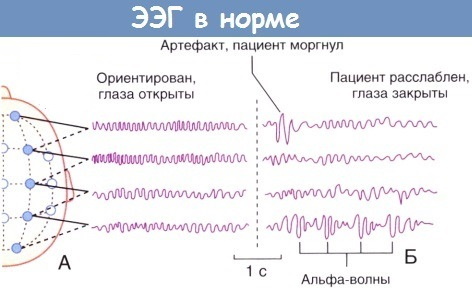
| Child's age | Normal indicators of bioelectrical activity of the central nervous system in the background |
| Full-term newborn infant without signs of pathology | The neurons of the brain work with the absence of an organized generation of rhythmic electric waves. In this case, the bioelectric impulses of the central nervous system of the newborn are low-amplitude with a spread within the range of up to 20 μV. |
| Children from 1 to 2.5 months | The amplitude of the biological potentials of the brain increases to 50 μV. The greatest activity of the central nervous system is observed in the central and occipital regions. The spread of bioelectric waves occurs synchronously and with a stable level of rhythmic organization. |
| A child aged 3 to 4 months. | In the central parts of the child's brain, a mu rhythm is determined, the amplitude of which varies from 20 to 50 μV. Moderate asymmetry between the right and left hemispheres is allowed. |
| Children from 4 to 6 months | Diffuse theta and delta activity is present in all parts of the newborn's CNS. The occipital and central regions of the brain exhibit a new level of bioelectric activity, which reaches from 6 to 8 oscillations per s. |
| Child from 6 months up to 12 months | Preservation of the bioelectrical activity of neurons is noted at the same level. |
| Children over 1 year old | There is an alpha brain rhythm. The frequency of bioelectric waves is from 5 to 7 oscillations per s. |
| Child from 2 years old | Alpha activity extends to all parts of the central nervous system, and the oscillation frequency of bioelectric waves corresponds to the range from 6 to 8 units. in with. |
| Children 3-4 years old | There is a change in the dominance of bioelectric waves towards the dominance of the theta range. The frequency of fluctuations in the rhythms of brain activity is from 7 to 9 units. in with. |
| Child aged 5-6 years | The formation of the alpha rhythm of the brain neurons with a frequency of wave oscillations from 7.5 to 10.2 units is observed. in sec. The bioelectrical activity of the child's central nervous system is most developed in the parietal and occipital region. |
By the age of 10-12, all children who have normal psychomotor development complete the process of maturation of the alpha rhythm. The highest frequency of oscillations of bioelectric waves is noted, which is in the range from 9 to 11 units. in with.
What do deviations from the norm say?
 Deviations from the above norms indicate an increasing or already present disease of the central nervous system. For an accurate diagnosis, additional examination of brain tissue using CT and MRI diagnostics will be required.
Deviations from the above norms indicate an increasing or already present disease of the central nervous system. For an accurate diagnosis, additional examination of brain tissue using CT and MRI diagnostics will be required.
What to do in case of violations
After detecting violations in the work of the central nervous system, the child is given a final diagnosis. Treatment tactics depend on the pathology of the brain, which was diagnosed based on the results of a comprehensive examination. This can be a surgical operation, taking medications that stimulate or suppress certain parts of the central nervous system.
Research cost
The average cost of electroencephalography of the brain is from 1,500 to 3,500 rubles.
EEG is a safe and informative diagnostic method that allows you to detect pathological disorders in the central nervous system in children and adult patients. Under conditions of normal functioning of the cerebral cortex, the results of electroencephalography will display the stable activity of neuronal cells in background, as well as their fast interaction under test load conditions (loud music, bright light source, fast and deep breath).
EEG is indicated for children with signs of vascular dystonia, hyperactivity, neurological and psychological disorders. The standard duration of this examination does not exceed 30 minutes. A deeper diagnosis of the central nervous system includes a long-term examination of the cerebral cortex during the child's day and night sleep.
Video about EEG for children
Electroencephalography for children - the need for:


